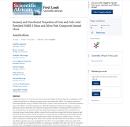Sensory and functional properties of iron and folic acid fortified nabe-3 bean and silver fish composite instant flour

View/
Date
2023-09Author
Geoffrey, Ssepuuya
Sharon, Hooper
Khadijah, Nakyinsige
Eria, Gyagenda Maseruka
Dianah, Musabi
Peter, Rukundo
Harriet, Kebirungi
Lorraine, Weatherspoon
Jose, Jackson-Malete
Metadata
Show full item recordAbstract
Despite the need for Iron and Folic acid (IFA) during critical stages of child development and gestation, there is observed persistence in deficiencies despite medical and intervention efforts. This situation motivated a food-based approach using IFA fortified NARO Bean-3 (NABE-3 bean) and silver fish. IFA fortified composites flours with NABE-3: silver fish proportions as 100:0, 90:10, 80:20, and 70:30 were developed. Functional, pasting and sensory properties were assessed using standard methods. Increasing silverfish proportions in the composite flours was associated with: decreased water absorption properties of the composite flours indicating reduced reconstitution abilities; reduced final viscosity but increased bulk density implying a high density of nutrients at lower viscosity and volume; increased peak time indicating increased cooking energy requirements; and reduced sensory acceptability [from liked moderately (7) to indifferent (5) on a 9-point hedonic scale] due to darkening of the colour, and increased intensity of fishy aroma and flavour. The 90:10 and 80:20 composites were more acceptable than the 70:30. The compressibility and hausner ratios of the flours were high and not significantly different, indicating low flowability of the bean flour and its composites with silver fish. Technological improvements should therefore maximize nutritional value while ensuring sensory acceptability and functionality.
